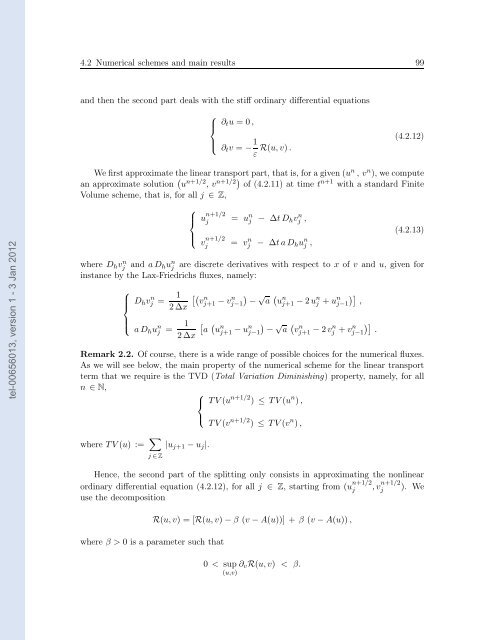Modélisation, analyse mathématique et simulations numériques de ...
Modélisation, analyse mathématique et simulations numériques de ...
Modélisation, analyse mathématique et simulations numériques de ...
You also want an ePaper? Increase the reach of your titles
YUMPU automatically turns print PDFs into web optimized ePapers that Google loves.
tel-00656013, version 1 - 3 Jan 2012<br />
4.2 Numerical schemes and main results 99<br />
and then the second part <strong>de</strong>als with the stiff ordinary differential equations<br />
⎧<br />
⎪⎨<br />
⎪⎩<br />
∂tu = 0,<br />
∂tv = − 1<br />
ε R(u,v).<br />
(4.2.12)<br />
We first approximate the linear transport part, that is, for a given(u n , v n ), we compute<br />
an approximate solution u n+1/2 , v n+1/2 of (4.2.11) at time t n+1 with a standard Finite<br />
Volume scheme, that is, for all j ∈ Z,<br />
where Dhv n j and aDhu n j<br />
⎧<br />
⎪⎨<br />
⎪⎩<br />
u n+1/2<br />
j<br />
v n+1/2<br />
j<br />
= u n j − ∆tDhv n j ,<br />
= v n j − ∆taDhu n j ,<br />
(4.2.13)<br />
are discr<strong>et</strong>e <strong>de</strong>rivatives with respect to x of v and u, given for<br />
instance by the Lax-Friedrichs fluxes, namely:<br />
⎧<br />
⎪⎨<br />
⎪⎩<br />
Dhv n j = 1<br />
2∆x<br />
aDhu n j<br />
= 1<br />
2∆x<br />
n<br />
vj+1 −v n √ n<br />
j−1 − a uj+1 −2u n j +u n <br />
j−1 ,<br />
<br />
n<br />
a uj+1 −u n √ <br />
n<br />
j−1 − a vj+1 −2v n j +vn <br />
j−1 .<br />
Remark 2.2. Of course, there is a wi<strong>de</strong> range of possible choices for the numerical fluxes.<br />
As we will see below, the main property of the numerical scheme for the linear transport<br />
term that we require is the TVD (Total Variation Diminishing) property, namely, for all<br />
n ∈ N,<br />
⎧<br />
⎨ TV(u n+1/2 ) ≤ TV(u n ),<br />
where TV(u) := <br />
j∈Z<br />
⎩<br />
|uj+1 −uj|.<br />
TV(v n+1/2 ) ≤ TV(v n ),<br />
Hence, the second part of the splitting only consists in approximating the nonlinear<br />
ordinary differential equation (4.2.12), for all j ∈ Z, starting from (u n+1/2<br />
j ,v n+1/2<br />
j ). We<br />
use the <strong>de</strong>composition<br />
where β > 0 is a param<strong>et</strong>er such that<br />
R(u,v) = [R(u,v)−β (v −A(u))] + β (v −A(u)),<br />
0 < sup ∂vR(u,v) < β.<br />
(u,v)

















